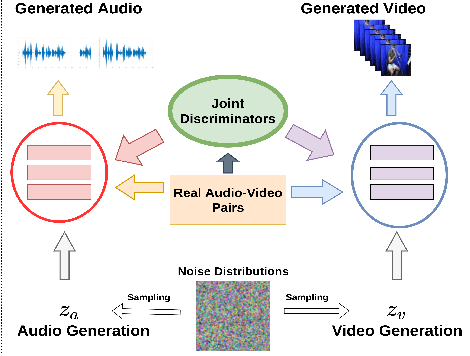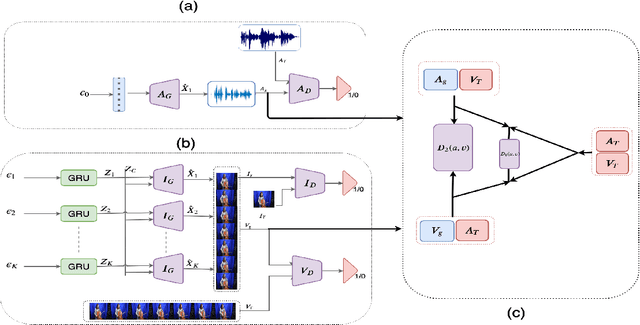K S Venkatesh
Collaborative Learning to Generate Audio-Video Jointly
Apr 01, 2021



Abstract:There have been a number of techniques that have demonstrated the generation of multimedia data for one modality at a time using GANs, such as the ability to generate images, videos, and audio. However, so far, the task of multi-modal generation of data, specifically for audio and videos both, has not been sufficiently well-explored. Towards this, we propose a method that demonstrates that we are able to generate naturalistic samples of video and audio data by the joint correlated generation of audio and video modalities. The proposed method uses multiple discriminators to ensure that the audio, video, and the joint output are also indistinguishable from real-world samples. We present a dataset for this task and show that we are able to generate realistic samples. This method is validated using various standard metrics such as Inception Score, Frechet Inception Distance (FID) and through human evaluation.
Bitwise Operations of Cellular Automaton on Gray-scale Images
May 19, 2017



Abstract:Cellular Automata (CA) theory is a discrete model that represents the state of each of its cells from a finite set of possible values which evolve in time according to a pre-defined set of transition rules. CA have been applied to a number of image processing tasks such as Convex Hull Detection, Image Denoising etc. but mostly under the limitation of restricting the input to binary images. In general, a gray-scale image may be converted to a number of different binary images which are finally recombined after CA operations on each of them individually. We have developed a multinomial regression based weighed summation method to recombine binary images for better performance of CA based Image Processing algorithms. The recombination algorithm is tested for the specific case of denoising Salt and Pepper Noise to test against standard benchmark algorithms such as the Median Filter for various images and noise levels. The results indicate several interesting invariances in the application of the CA, such as the particular noise realization and the choice of sub-sampling of pixels to determine recombination weights. Additionally, it appears that simpler algorithms for weight optimization which seek local minima work as effectively as those that seek global minima such as Simulated Annealing.
 Add to Chrome
Add to Chrome Add to Firefox
Add to Firefox Add to Edge
Add to Edge